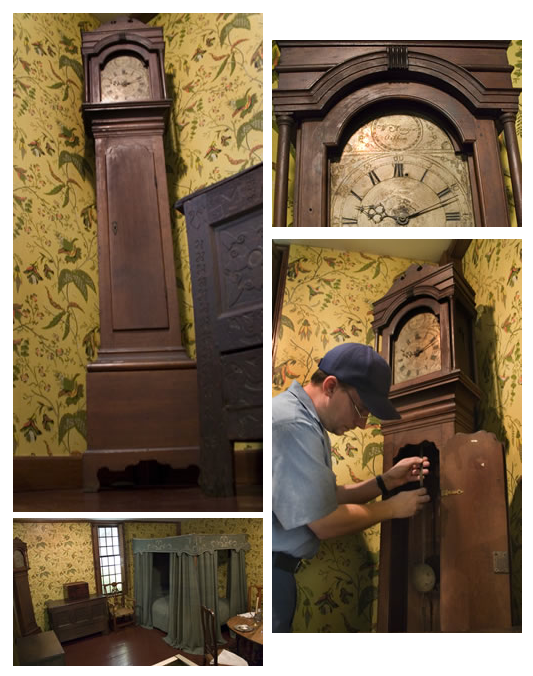DAR Takes on Myths of Early America

- Photos by Jill Connor
MYTHS: In the Daughters of the American Revolution Museum in Washington D.C. down the street from the White House houses a number of artifacts from the Worcester area especially in the Massachusetts room shown here. In the corner stands a grandfather clock made in Oakham by William Crawford between 1790-1820. Patrick Sheary, is originally from Worcester but now lives in D.C. and works as the Curator of Furnishings for the DAR museum.
MYTHS
Worcester Telegram & Gazette
Katie Geyer
Boston University News Service
November 2, 2006
WASHINGTON, Nov. 2 — The tall wooden timepiece built in Oakham, Mass., and now on display at the Daughters of the American Revolution Museum here can be called a tall clock or a case clock. But never call it a grandfather clock.
The Daughters of the American Revolution (DAR), with a mission of promoting historic education and preservation, is out to set the record straight. Tall clocks were not called grandfather clocks until the 1870s, when the song “My Grandfather’s Clock” became popular. So tall clocks like this one, made by William Crawford between 1790 and 1820, must not be labeled “grandfather.”
The clock myth is part of the DAR’s exhibit, “Myth or Truth? Stories We’ve Heard about Early America,” which began on Oct. 6 and will run until next March 31 at the museum. The grandfather clock myth is one of many that the museum director, Diane Dunkley, says have been driving the DAR and other American history buffs crazy.
“They’re the sorts of things that historians know but the general public doesn’t know,” she said. “There’s a lot of discussion [at the DAR] all the time about ‘did you hear this one?’ ”
And so was born an exhibit that challenges silverware, flag makers, door hinges, Yankee Doodle and the number 13.
Ms. Dunkley said the myths come in several different forms.
“There are myths that start out with a kernel of truth and then just sort of get embellished for whatever reason,” she said. “It’s like playing a game of whispers.”
“And then there are things that people just make up to explain things,” Ms. Dunkley said.
Patrick Sheary, the DAR Museum’s curator of furnishings, is a native of Worcester and regularly maintains furniture in the museum’s various state rooms, including the Massachusetts room. The room is a replica of the front parlor of the Hancock-Clarke House in Lexington, Mass., where John Hancock and Samuel Adams were said to have been when they heard Paul Revere’s message in 1775 that the British were coming.
Mr. Sheary, who has worked there for 11 years, said that the most famous item in the room is a Chinese tea chest said to have been one of the two surviving tea chests thrown into Boston Harbor during the Boston Tea Party in 1773.
“It conjures up lots of debate,” Mr. Sheary said, because without the presence of water marks, he said, the DAR questions whether the box had any involvement with the Boston Tea Party.
One myth featured in the DAR’s exhibit is the common assumption that people were shorter, on average, during the revolutionary period, than they are today. The DAR says scholars have compared the average height of Revolutionary soldiers with the height of soldiers in the 20th century, and the difference is within fractions of an inch.
Similarly, at Old Sturbridge Village in Sturbridge, Mass., curator Tom Kelleher frequently explains to visitors that the village’s low-ceilinged revolutionary period houses are not necessarily evidence that people were shorter back then.
When people make assumptions about the low ceilings, he said, he asks them, “Well, are you hitting your head?” Although the ceilings seem low, “you don’t have to duck,” he said.
Mr. Kelleher said that Americans have come to expect a certain amount of space in a house and that high ceilings would have been seen as a waste of material and of heat back then.
The curator echoed the DAR’s warning about historical myths.
“Good stories stick in our minds,” he said. When people hear of evidence that Americans have changed, he said, they think it is very interesting. But as interesting as these stories sound, Mr. Kelleher said, it is best to have a healthy skepticism.
He said questioning history teaches critical thinking. “Not just about history, but about life in general,” he said.
But Kenneth J. Moynihan, a professor of history at Assumption College, said that myths about height and artifacts and the like may catch the public’s eye, but they are not the kind that really have power. “We have myths about everything,” he said. “Some of them are important and some of them are not.”
For example, he said, there is a powerful myth that surrounds the founding of our nation. “A major factor in our self identity is that either we bought the land fair and square or the Indians had it coming because they [attacked] the white people,” he said. “That’s the level of myth that really has power, not necessarily myths about how tall people were.”
The professor said he is working on a book about Worcester’s early history in which he plans to challenge some of the assumptions about the town’s past.
Ms. Dunkley of the DAR said the public as well as historians should always question the sources of their information.
“What we really want the public to do is say, ‘OK, that’s an interesting story.’ Then go see what they can find out.”
###

